Business Process Management at IBM: Case Study Analysis and Review
VerifiedAdded on 2020/04/13
|21
|7267
|149
Report
AI Summary
This report provides a critical evaluation of IBM's business process management, focusing on innovation strategies, organizational structure, and business process design. It analyzes IBM's approach to innovation, including its framework, funding models, and integration of business and technology. The report delves into the company's innovation strategy, leadership, and key stakeholders, examining how they drive and manage innovation. Furthermore, it assesses risk issues, potential change management strategies, and performance evaluation methods, including metrics and the balance scorecard. The analysis incorporates the challenges faced by IBM, such as barriers to innovation and dealing with failures, concluding with lessons learned and recommendations for future improvements. The report is based on a case study and other sources, providing a comprehensive overview of IBM's business process management practices.
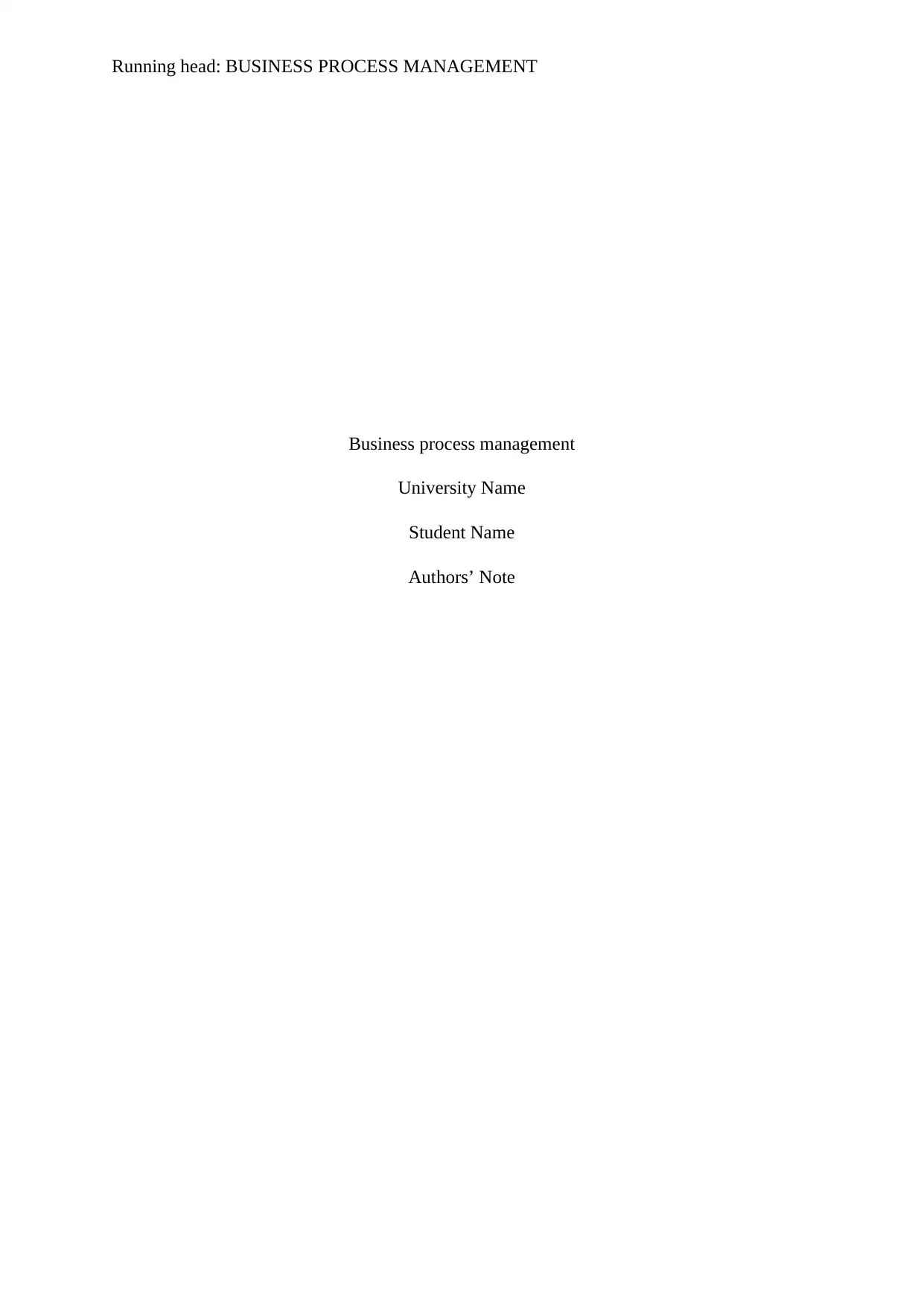
Running head: BUSINESS PROCESS MANAGEMENT
Business process management
University Name
Student Name
Authors’ Note
Business process management
University Name
Student Name
Authors’ Note
Paraphrase This Document
Need a fresh take? Get an instant paraphrase of this document with our AI Paraphraser
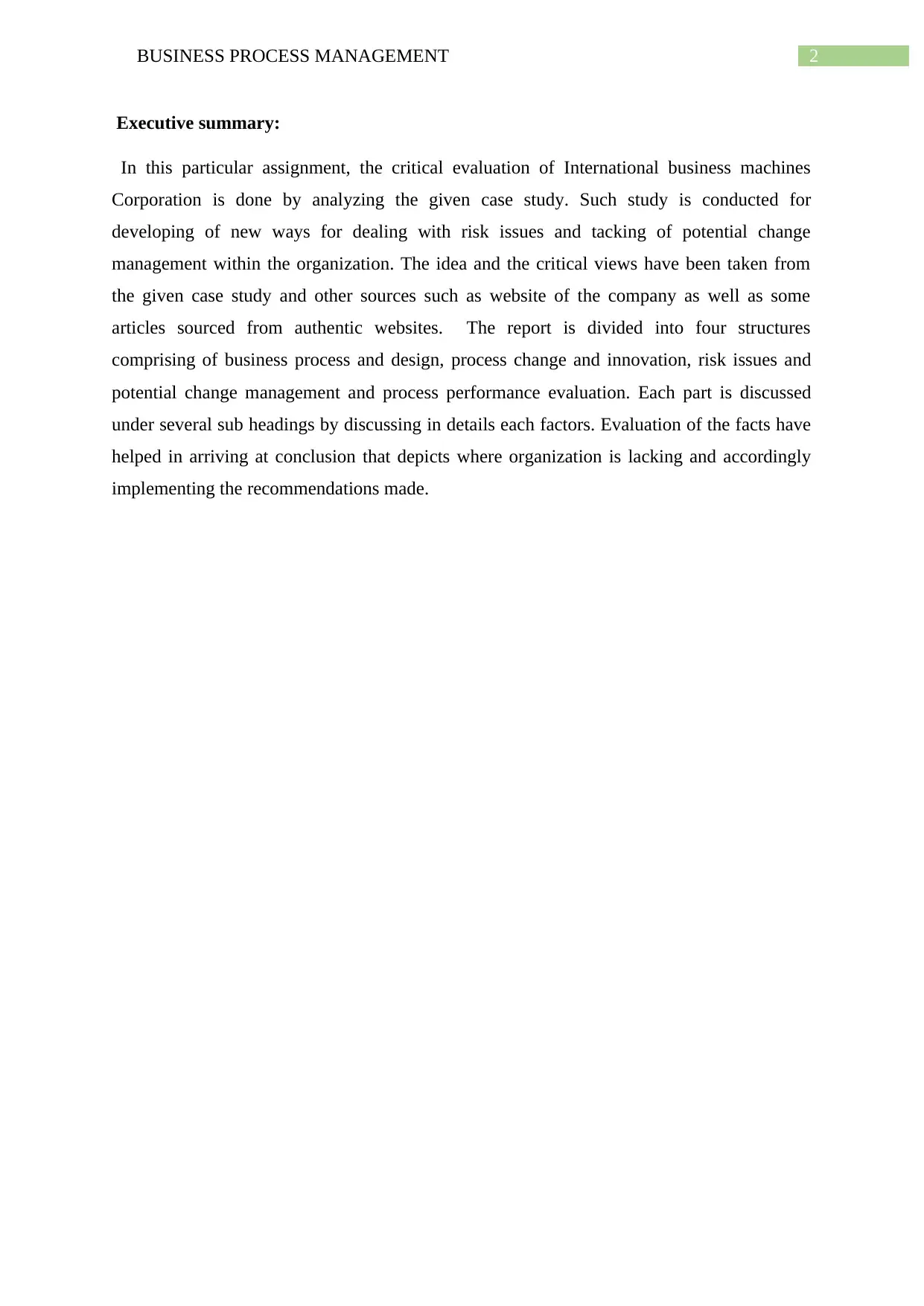
2BUSINESS PROCESS MANAGEMENT
Executive summary:
In this particular assignment, the critical evaluation of International business machines
Corporation is done by analyzing the given case study. Such study is conducted for
developing of new ways for dealing with risk issues and tacking of potential change
management within the organization. The idea and the critical views have been taken from
the given case study and other sources such as website of the company as well as some
articles sourced from authentic websites. The report is divided into four structures
comprising of business process and design, process change and innovation, risk issues and
potential change management and process performance evaluation. Each part is discussed
under several sub headings by discussing in details each factors. Evaluation of the facts have
helped in arriving at conclusion that depicts where organization is lacking and accordingly
implementing the recommendations made.
Executive summary:
In this particular assignment, the critical evaluation of International business machines
Corporation is done by analyzing the given case study. Such study is conducted for
developing of new ways for dealing with risk issues and tacking of potential change
management within the organization. The idea and the critical views have been taken from
the given case study and other sources such as website of the company as well as some
articles sourced from authentic websites. The report is divided into four structures
comprising of business process and design, process change and innovation, risk issues and
potential change management and process performance evaluation. Each part is discussed
under several sub headings by discussing in details each factors. Evaluation of the facts have
helped in arriving at conclusion that depicts where organization is lacking and accordingly
implementing the recommendations made.
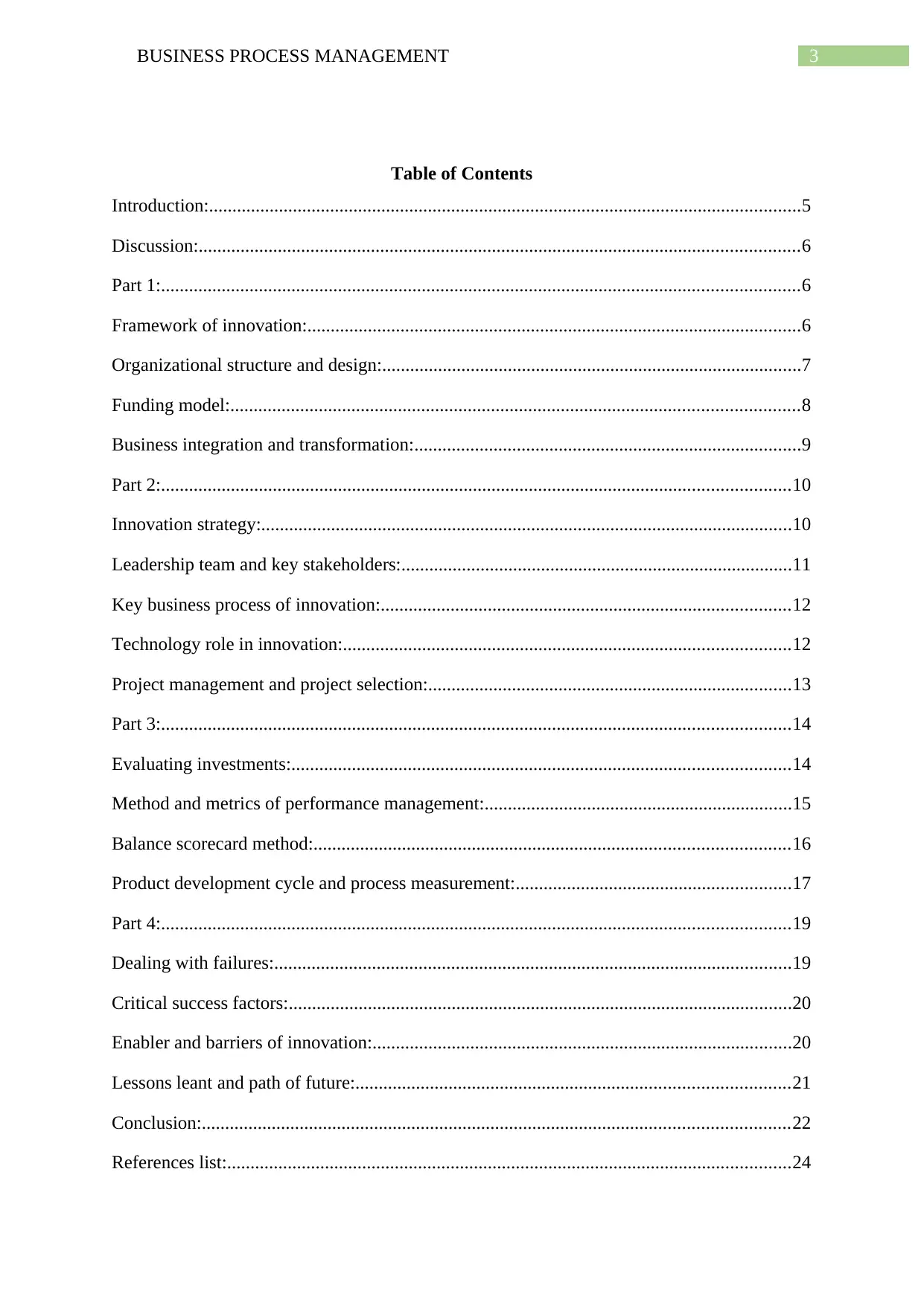
3BUSINESS PROCESS MANAGEMENT
Table of Contents
Introduction:...............................................................................................................................5
Discussion:.................................................................................................................................6
Part 1:.........................................................................................................................................6
Framework of innovation:..........................................................................................................6
Organizational structure and design:..........................................................................................7
Funding model:..........................................................................................................................8
Business integration and transformation:...................................................................................9
Part 2:.......................................................................................................................................10
Innovation strategy:..................................................................................................................10
Leadership team and key stakeholders:....................................................................................11
Key business process of innovation:........................................................................................12
Technology role in innovation:................................................................................................12
Project management and project selection:..............................................................................13
Part 3:.......................................................................................................................................14
Evaluating investments:...........................................................................................................14
Method and metrics of performance management:..................................................................15
Balance scorecard method:......................................................................................................16
Product development cycle and process measurement:...........................................................17
Part 4:.......................................................................................................................................19
Dealing with failures:...............................................................................................................19
Critical success factors:............................................................................................................20
Enabler and barriers of innovation:..........................................................................................20
Lessons leant and path of future:.............................................................................................21
Conclusion:..............................................................................................................................22
References list:.........................................................................................................................24
Table of Contents
Introduction:...............................................................................................................................5
Discussion:.................................................................................................................................6
Part 1:.........................................................................................................................................6
Framework of innovation:..........................................................................................................6
Organizational structure and design:..........................................................................................7
Funding model:..........................................................................................................................8
Business integration and transformation:...................................................................................9
Part 2:.......................................................................................................................................10
Innovation strategy:..................................................................................................................10
Leadership team and key stakeholders:....................................................................................11
Key business process of innovation:........................................................................................12
Technology role in innovation:................................................................................................12
Project management and project selection:..............................................................................13
Part 3:.......................................................................................................................................14
Evaluating investments:...........................................................................................................14
Method and metrics of performance management:..................................................................15
Balance scorecard method:......................................................................................................16
Product development cycle and process measurement:...........................................................17
Part 4:.......................................................................................................................................19
Dealing with failures:...............................................................................................................19
Critical success factors:............................................................................................................20
Enabler and barriers of innovation:..........................................................................................20
Lessons leant and path of future:.............................................................................................21
Conclusion:..............................................................................................................................22
References list:.........................................................................................................................24
⊘ This is a preview!⊘
Do you want full access?
Subscribe today to unlock all pages.

Trusted by 1+ million students worldwide
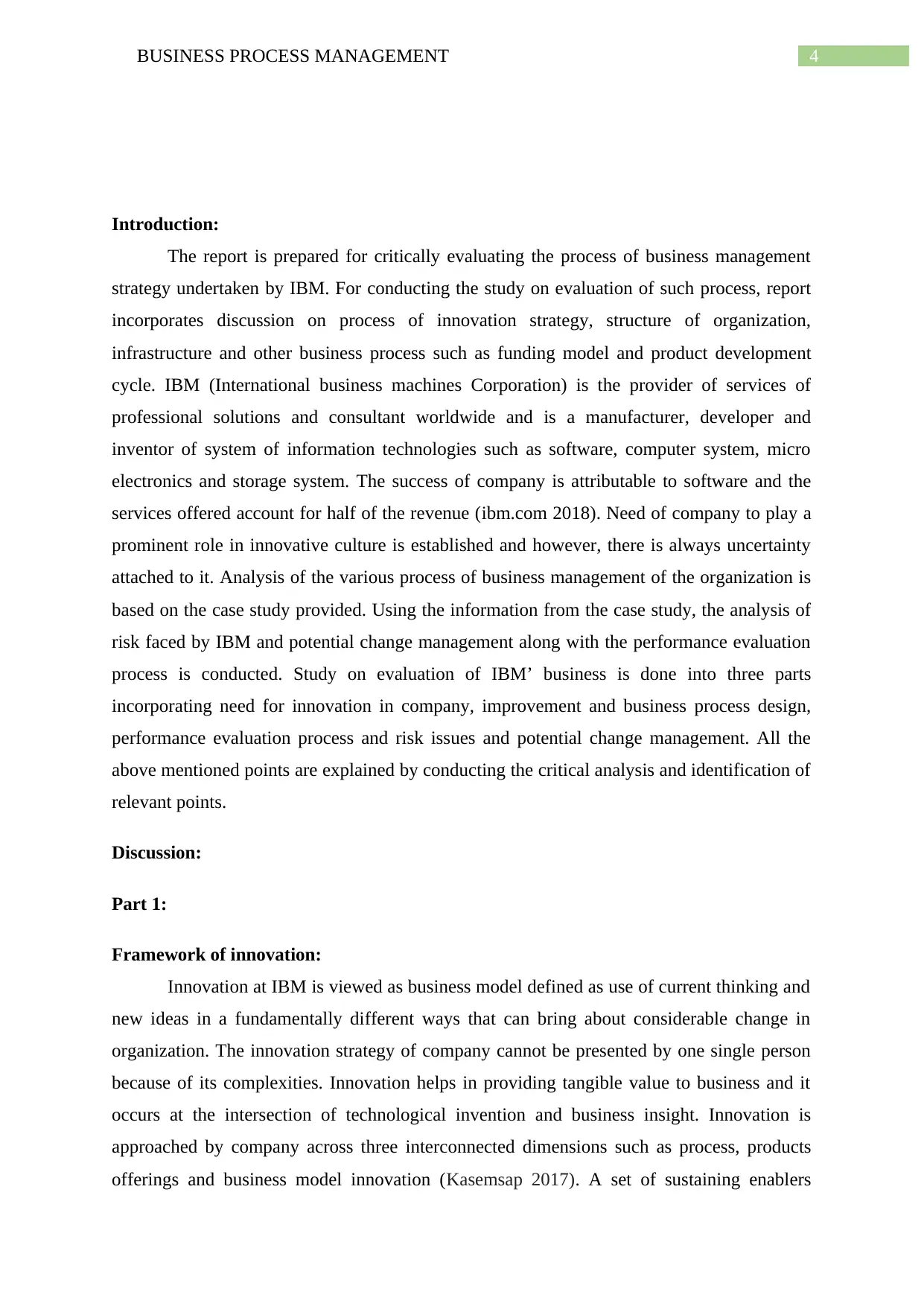
4BUSINESS PROCESS MANAGEMENT
Introduction:
The report is prepared for critically evaluating the process of business management
strategy undertaken by IBM. For conducting the study on evaluation of such process, report
incorporates discussion on process of innovation strategy, structure of organization,
infrastructure and other business process such as funding model and product development
cycle. IBM (International business machines Corporation) is the provider of services of
professional solutions and consultant worldwide and is a manufacturer, developer and
inventor of system of information technologies such as software, computer system, micro
electronics and storage system. The success of company is attributable to software and the
services offered account for half of the revenue (ibm.com 2018). Need of company to play a
prominent role in innovative culture is established and however, there is always uncertainty
attached to it. Analysis of the various process of business management of the organization is
based on the case study provided. Using the information from the case study, the analysis of
risk faced by IBM and potential change management along with the performance evaluation
process is conducted. Study on evaluation of IBM’ business is done into three parts
incorporating need for innovation in company, improvement and business process design,
performance evaluation process and risk issues and potential change management. All the
above mentioned points are explained by conducting the critical analysis and identification of
relevant points.
Discussion:
Part 1:
Framework of innovation:
Innovation at IBM is viewed as business model defined as use of current thinking and
new ideas in a fundamentally different ways that can bring about considerable change in
organization. The innovation strategy of company cannot be presented by one single person
because of its complexities. Innovation helps in providing tangible value to business and it
occurs at the intersection of technological invention and business insight. Innovation is
approached by company across three interconnected dimensions such as process, products
offerings and business model innovation (Kasemsap 2017). A set of sustaining enablers
Introduction:
The report is prepared for critically evaluating the process of business management
strategy undertaken by IBM. For conducting the study on evaluation of such process, report
incorporates discussion on process of innovation strategy, structure of organization,
infrastructure and other business process such as funding model and product development
cycle. IBM (International business machines Corporation) is the provider of services of
professional solutions and consultant worldwide and is a manufacturer, developer and
inventor of system of information technologies such as software, computer system, micro
electronics and storage system. The success of company is attributable to software and the
services offered account for half of the revenue (ibm.com 2018). Need of company to play a
prominent role in innovative culture is established and however, there is always uncertainty
attached to it. Analysis of the various process of business management of the organization is
based on the case study provided. Using the information from the case study, the analysis of
risk faced by IBM and potential change management along with the performance evaluation
process is conducted. Study on evaluation of IBM’ business is done into three parts
incorporating need for innovation in company, improvement and business process design,
performance evaluation process and risk issues and potential change management. All the
above mentioned points are explained by conducting the critical analysis and identification of
relevant points.
Discussion:
Part 1:
Framework of innovation:
Innovation at IBM is viewed as business model defined as use of current thinking and
new ideas in a fundamentally different ways that can bring about considerable change in
organization. The innovation strategy of company cannot be presented by one single person
because of its complexities. Innovation helps in providing tangible value to business and it
occurs at the intersection of technological invention and business insight. Innovation is
approached by company across three interconnected dimensions such as process, products
offerings and business model innovation (Kasemsap 2017). A set of sustaining enablers
Paraphrase This Document
Need a fresh take? Get an instant paraphrase of this document with our AI Paraphraser
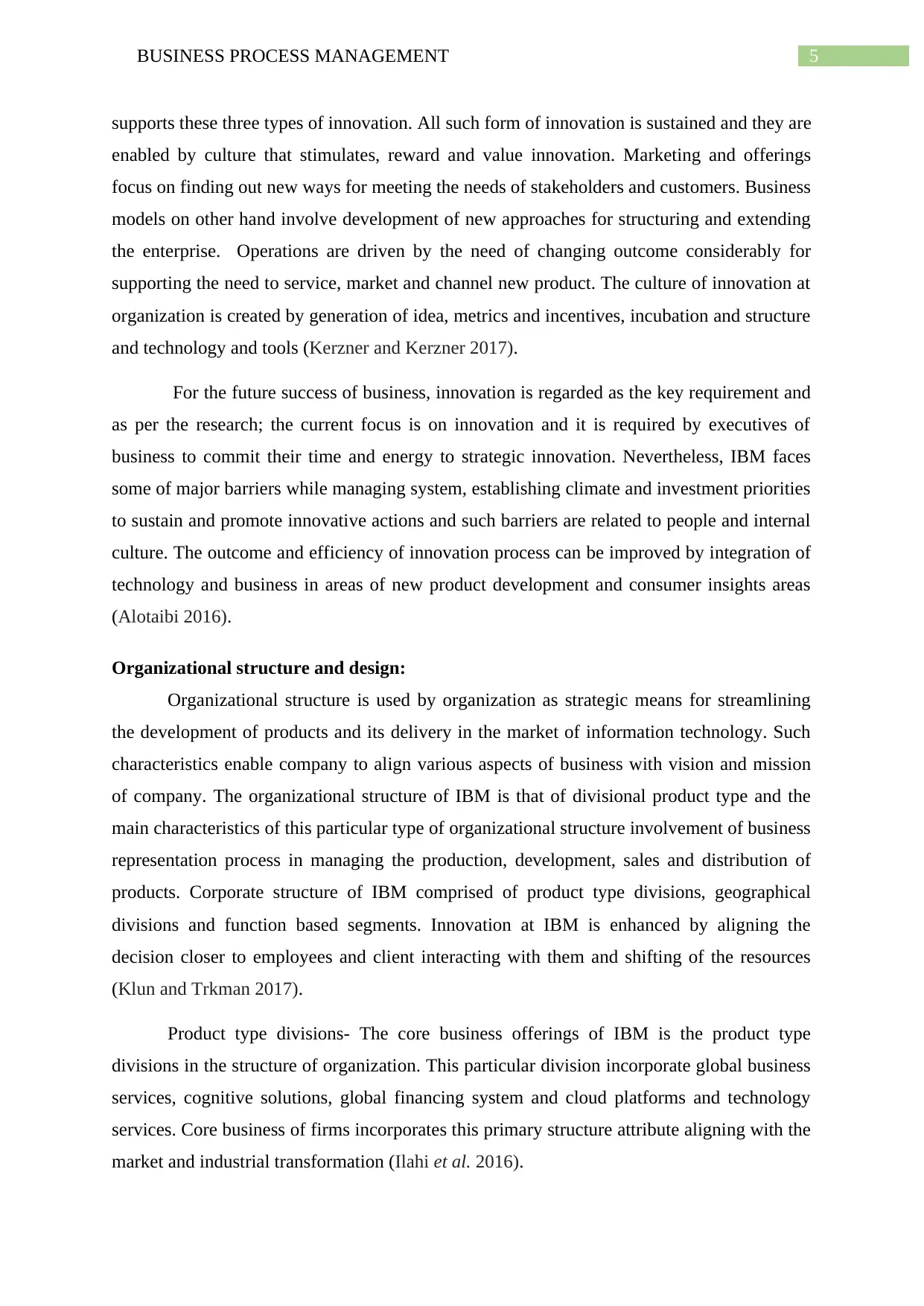
5BUSINESS PROCESS MANAGEMENT
supports these three types of innovation. All such form of innovation is sustained and they are
enabled by culture that stimulates, reward and value innovation. Marketing and offerings
focus on finding out new ways for meeting the needs of stakeholders and customers. Business
models on other hand involve development of new approaches for structuring and extending
the enterprise. Operations are driven by the need of changing outcome considerably for
supporting the need to service, market and channel new product. The culture of innovation at
organization is created by generation of idea, metrics and incentives, incubation and structure
and technology and tools (Kerzner and Kerzner 2017).
For the future success of business, innovation is regarded as the key requirement and
as per the research; the current focus is on innovation and it is required by executives of
business to commit their time and energy to strategic innovation. Nevertheless, IBM faces
some of major barriers while managing system, establishing climate and investment priorities
to sustain and promote innovative actions and such barriers are related to people and internal
culture. The outcome and efficiency of innovation process can be improved by integration of
technology and business in areas of new product development and consumer insights areas
(Alotaibi 2016).
Organizational structure and design:
Organizational structure is used by organization as strategic means for streamlining
the development of products and its delivery in the market of information technology. Such
characteristics enable company to align various aspects of business with vision and mission
of company. The organizational structure of IBM is that of divisional product type and the
main characteristics of this particular type of organizational structure involvement of business
representation process in managing the production, development, sales and distribution of
products. Corporate structure of IBM comprised of product type divisions, geographical
divisions and function based segments. Innovation at IBM is enhanced by aligning the
decision closer to employees and client interacting with them and shifting of the resources
(Klun and Trkman 2017).
Product type divisions- The core business offerings of IBM is the product type
divisions in the structure of organization. This particular division incorporate global business
services, cognitive solutions, global financing system and cloud platforms and technology
services. Core business of firms incorporates this primary structure attribute aligning with the
market and industrial transformation (Ilahi et al. 2016).
supports these three types of innovation. All such form of innovation is sustained and they are
enabled by culture that stimulates, reward and value innovation. Marketing and offerings
focus on finding out new ways for meeting the needs of stakeholders and customers. Business
models on other hand involve development of new approaches for structuring and extending
the enterprise. Operations are driven by the need of changing outcome considerably for
supporting the need to service, market and channel new product. The culture of innovation at
organization is created by generation of idea, metrics and incentives, incubation and structure
and technology and tools (Kerzner and Kerzner 2017).
For the future success of business, innovation is regarded as the key requirement and
as per the research; the current focus is on innovation and it is required by executives of
business to commit their time and energy to strategic innovation. Nevertheless, IBM faces
some of major barriers while managing system, establishing climate and investment priorities
to sustain and promote innovative actions and such barriers are related to people and internal
culture. The outcome and efficiency of innovation process can be improved by integration of
technology and business in areas of new product development and consumer insights areas
(Alotaibi 2016).
Organizational structure and design:
Organizational structure is used by organization as strategic means for streamlining
the development of products and its delivery in the market of information technology. Such
characteristics enable company to align various aspects of business with vision and mission
of company. The organizational structure of IBM is that of divisional product type and the
main characteristics of this particular type of organizational structure involvement of business
representation process in managing the production, development, sales and distribution of
products. Corporate structure of IBM comprised of product type divisions, geographical
divisions and function based segments. Innovation at IBM is enhanced by aligning the
decision closer to employees and client interacting with them and shifting of the resources
(Klun and Trkman 2017).
Product type divisions- The core business offerings of IBM is the product type
divisions in the structure of organization. This particular division incorporate global business
services, cognitive solutions, global financing system and cloud platforms and technology
services. Core business of firms incorporates this primary structure attribute aligning with the
market and industrial transformation (Ilahi et al. 2016).
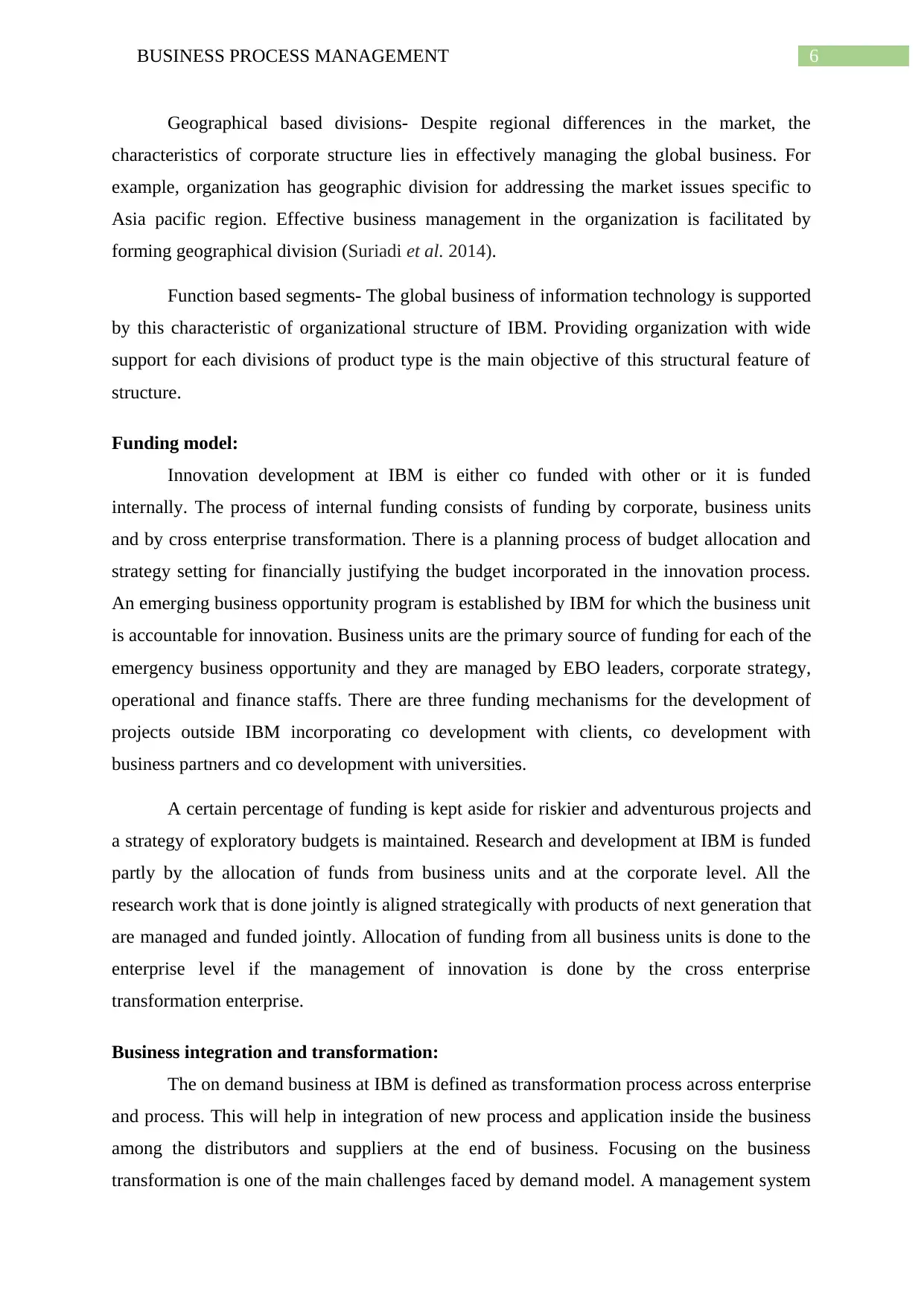
6BUSINESS PROCESS MANAGEMENT
Geographical based divisions- Despite regional differences in the market, the
characteristics of corporate structure lies in effectively managing the global business. For
example, organization has geographic division for addressing the market issues specific to
Asia pacific region. Effective business management in the organization is facilitated by
forming geographical division (Suriadi et al. 2014).
Function based segments- The global business of information technology is supported
by this characteristic of organizational structure of IBM. Providing organization with wide
support for each divisions of product type is the main objective of this structural feature of
structure.
Funding model:
Innovation development at IBM is either co funded with other or it is funded
internally. The process of internal funding consists of funding by corporate, business units
and by cross enterprise transformation. There is a planning process of budget allocation and
strategy setting for financially justifying the budget incorporated in the innovation process.
An emerging business opportunity program is established by IBM for which the business unit
is accountable for innovation. Business units are the primary source of funding for each of the
emergency business opportunity and they are managed by EBO leaders, corporate strategy,
operational and finance staffs. There are three funding mechanisms for the development of
projects outside IBM incorporating co development with clients, co development with
business partners and co development with universities.
A certain percentage of funding is kept aside for riskier and adventurous projects and
a strategy of exploratory budgets is maintained. Research and development at IBM is funded
partly by the allocation of funds from business units and at the corporate level. All the
research work that is done jointly is aligned strategically with products of next generation that
are managed and funded jointly. Allocation of funding from all business units is done to the
enterprise level if the management of innovation is done by the cross enterprise
transformation enterprise.
Business integration and transformation:
The on demand business at IBM is defined as transformation process across enterprise
and process. This will help in integration of new process and application inside the business
among the distributors and suppliers at the end of business. Focusing on the business
transformation is one of the main challenges faced by demand model. A management system
Geographical based divisions- Despite regional differences in the market, the
characteristics of corporate structure lies in effectively managing the global business. For
example, organization has geographic division for addressing the market issues specific to
Asia pacific region. Effective business management in the organization is facilitated by
forming geographical division (Suriadi et al. 2014).
Function based segments- The global business of information technology is supported
by this characteristic of organizational structure of IBM. Providing organization with wide
support for each divisions of product type is the main objective of this structural feature of
structure.
Funding model:
Innovation development at IBM is either co funded with other or it is funded
internally. The process of internal funding consists of funding by corporate, business units
and by cross enterprise transformation. There is a planning process of budget allocation and
strategy setting for financially justifying the budget incorporated in the innovation process.
An emerging business opportunity program is established by IBM for which the business unit
is accountable for innovation. Business units are the primary source of funding for each of the
emergency business opportunity and they are managed by EBO leaders, corporate strategy,
operational and finance staffs. There are three funding mechanisms for the development of
projects outside IBM incorporating co development with clients, co development with
business partners and co development with universities.
A certain percentage of funding is kept aside for riskier and adventurous projects and
a strategy of exploratory budgets is maintained. Research and development at IBM is funded
partly by the allocation of funds from business units and at the corporate level. All the
research work that is done jointly is aligned strategically with products of next generation that
are managed and funded jointly. Allocation of funding from all business units is done to the
enterprise level if the management of innovation is done by the cross enterprise
transformation enterprise.
Business integration and transformation:
The on demand business at IBM is defined as transformation process across enterprise
and process. This will help in integration of new process and application inside the business
among the distributors and suppliers at the end of business. Focusing on the business
transformation is one of the main challenges faced by demand model. A management system
⊘ This is a preview!⊘
Do you want full access?
Subscribe today to unlock all pages.

Trusted by 1+ million students worldwide
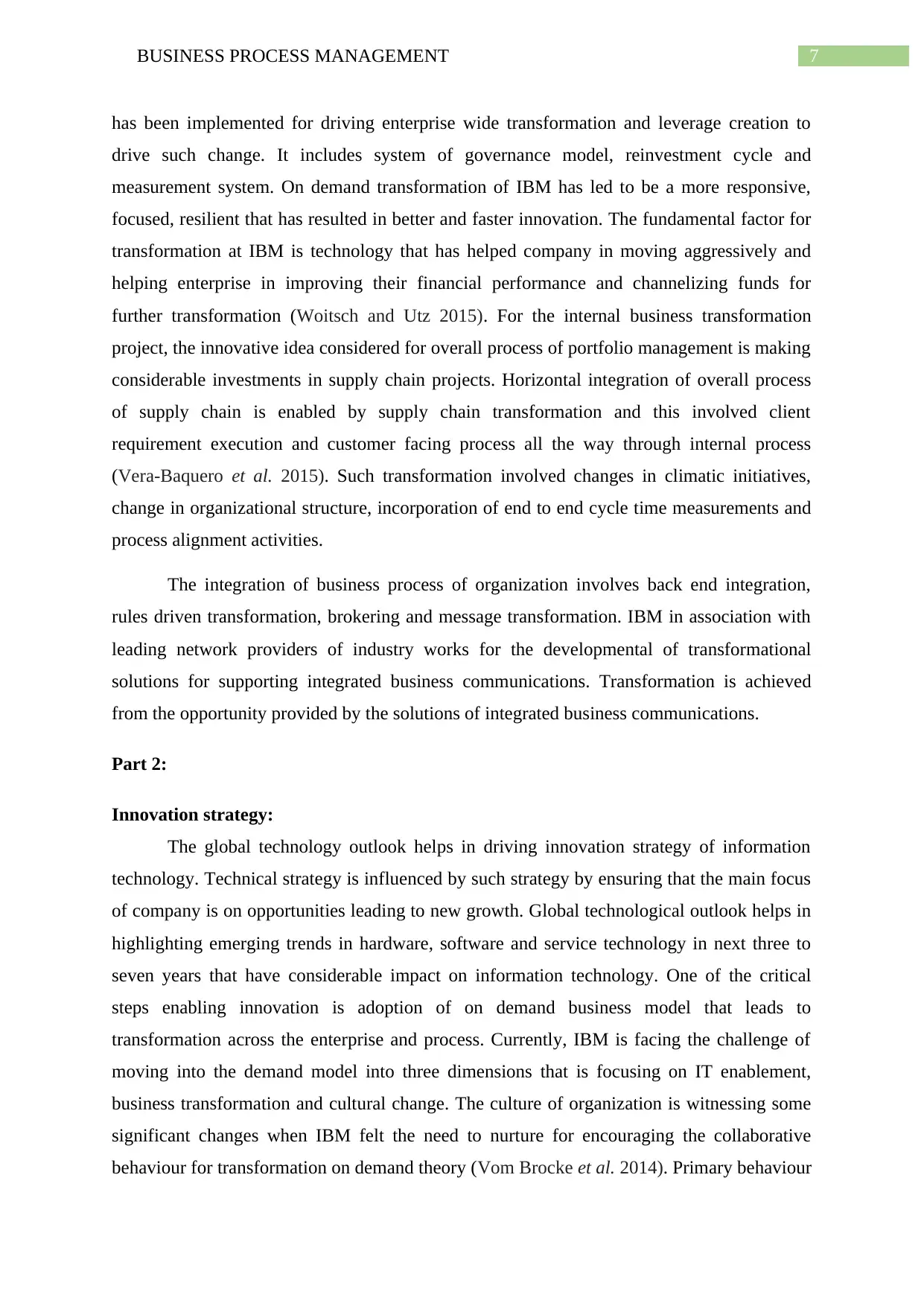
7BUSINESS PROCESS MANAGEMENT
has been implemented for driving enterprise wide transformation and leverage creation to
drive such change. It includes system of governance model, reinvestment cycle and
measurement system. On demand transformation of IBM has led to be a more responsive,
focused, resilient that has resulted in better and faster innovation. The fundamental factor for
transformation at IBM is technology that has helped company in moving aggressively and
helping enterprise in improving their financial performance and channelizing funds for
further transformation (Woitsch and Utz 2015). For the internal business transformation
project, the innovative idea considered for overall process of portfolio management is making
considerable investments in supply chain projects. Horizontal integration of overall process
of supply chain is enabled by supply chain transformation and this involved client
requirement execution and customer facing process all the way through internal process
(Vera-Baquero et al. 2015). Such transformation involved changes in climatic initiatives,
change in organizational structure, incorporation of end to end cycle time measurements and
process alignment activities.
The integration of business process of organization involves back end integration,
rules driven transformation, brokering and message transformation. IBM in association with
leading network providers of industry works for the developmental of transformational
solutions for supporting integrated business communications. Transformation is achieved
from the opportunity provided by the solutions of integrated business communications.
Part 2:
Innovation strategy:
The global technology outlook helps in driving innovation strategy of information
technology. Technical strategy is influenced by such strategy by ensuring that the main focus
of company is on opportunities leading to new growth. Global technological outlook helps in
highlighting emerging trends in hardware, software and service technology in next three to
seven years that have considerable impact on information technology. One of the critical
steps enabling innovation is adoption of on demand business model that leads to
transformation across the enterprise and process. Currently, IBM is facing the challenge of
moving into the demand model into three dimensions that is focusing on IT enablement,
business transformation and cultural change. The culture of organization is witnessing some
significant changes when IBM felt the need to nurture for encouraging the collaborative
behaviour for transformation on demand theory (Vom Brocke et al. 2014). Primary behaviour
has been implemented for driving enterprise wide transformation and leverage creation to
drive such change. It includes system of governance model, reinvestment cycle and
measurement system. On demand transformation of IBM has led to be a more responsive,
focused, resilient that has resulted in better and faster innovation. The fundamental factor for
transformation at IBM is technology that has helped company in moving aggressively and
helping enterprise in improving their financial performance and channelizing funds for
further transformation (Woitsch and Utz 2015). For the internal business transformation
project, the innovative idea considered for overall process of portfolio management is making
considerable investments in supply chain projects. Horizontal integration of overall process
of supply chain is enabled by supply chain transformation and this involved client
requirement execution and customer facing process all the way through internal process
(Vera-Baquero et al. 2015). Such transformation involved changes in climatic initiatives,
change in organizational structure, incorporation of end to end cycle time measurements and
process alignment activities.
The integration of business process of organization involves back end integration,
rules driven transformation, brokering and message transformation. IBM in association with
leading network providers of industry works for the developmental of transformational
solutions for supporting integrated business communications. Transformation is achieved
from the opportunity provided by the solutions of integrated business communications.
Part 2:
Innovation strategy:
The global technology outlook helps in driving innovation strategy of information
technology. Technical strategy is influenced by such strategy by ensuring that the main focus
of company is on opportunities leading to new growth. Global technological outlook helps in
highlighting emerging trends in hardware, software and service technology in next three to
seven years that have considerable impact on information technology. One of the critical
steps enabling innovation is adoption of on demand business model that leads to
transformation across the enterprise and process. Currently, IBM is facing the challenge of
moving into the demand model into three dimensions that is focusing on IT enablement,
business transformation and cultural change. The culture of organization is witnessing some
significant changes when IBM felt the need to nurture for encouraging the collaborative
behaviour for transformation on demand theory (Vom Brocke et al. 2014). Primary behaviour
Paraphrase This Document
Need a fresh take? Get an instant paraphrase of this document with our AI Paraphraser
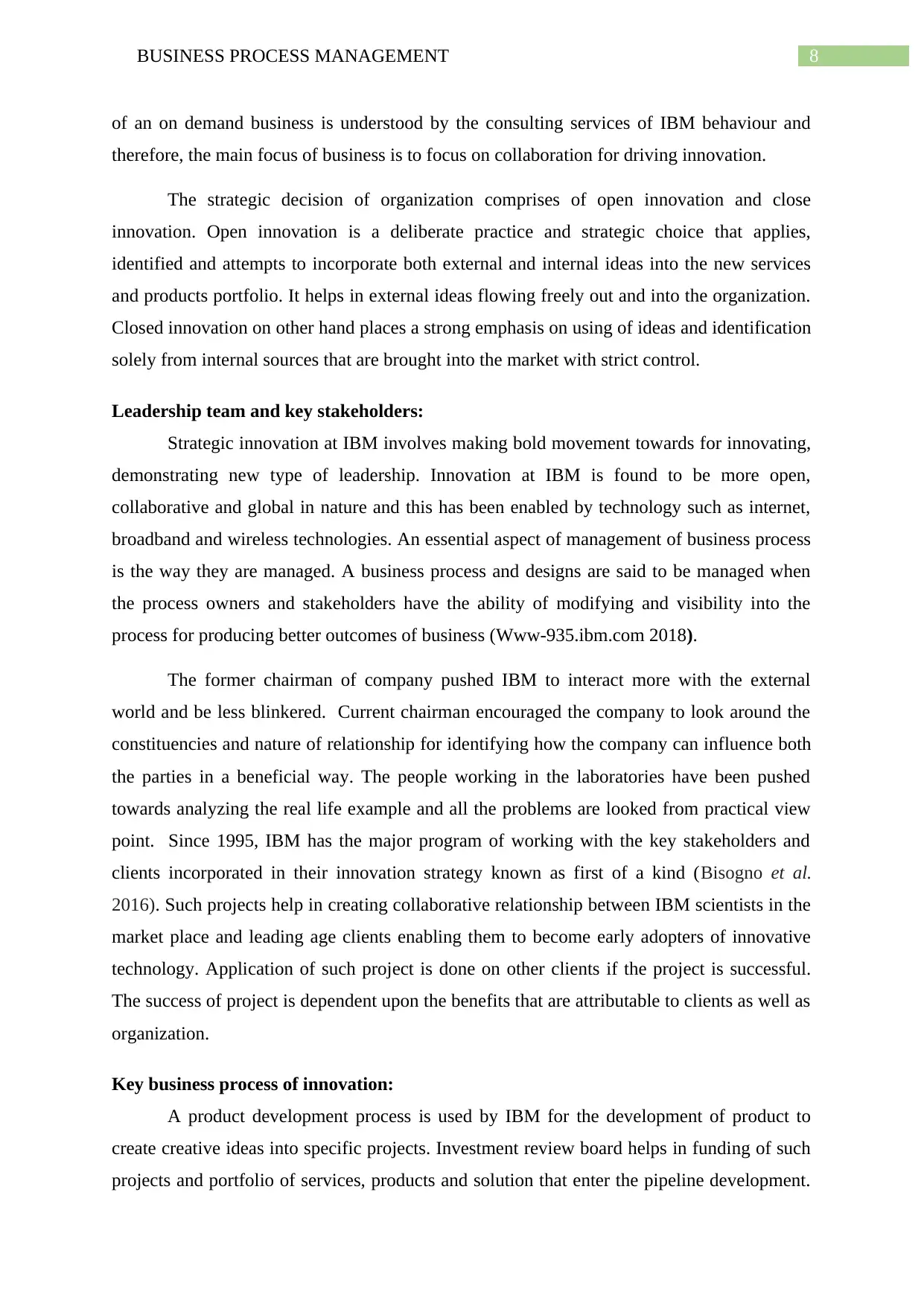
8BUSINESS PROCESS MANAGEMENT
of an on demand business is understood by the consulting services of IBM behaviour and
therefore, the main focus of business is to focus on collaboration for driving innovation.
The strategic decision of organization comprises of open innovation and close
innovation. Open innovation is a deliberate practice and strategic choice that applies,
identified and attempts to incorporate both external and internal ideas into the new services
and products portfolio. It helps in external ideas flowing freely out and into the organization.
Closed innovation on other hand places a strong emphasis on using of ideas and identification
solely from internal sources that are brought into the market with strict control.
Leadership team and key stakeholders:
Strategic innovation at IBM involves making bold movement towards for innovating,
demonstrating new type of leadership. Innovation at IBM is found to be more open,
collaborative and global in nature and this has been enabled by technology such as internet,
broadband and wireless technologies. An essential aspect of management of business process
is the way they are managed. A business process and designs are said to be managed when
the process owners and stakeholders have the ability of modifying and visibility into the
process for producing better outcomes of business (Www-935.ibm.com 2018).
The former chairman of company pushed IBM to interact more with the external
world and be less blinkered. Current chairman encouraged the company to look around the
constituencies and nature of relationship for identifying how the company can influence both
the parties in a beneficial way. The people working in the laboratories have been pushed
towards analyzing the real life example and all the problems are looked from practical view
point. Since 1995, IBM has the major program of working with the key stakeholders and
clients incorporated in their innovation strategy known as first of a kind (Bisogno et al.
2016). Such projects help in creating collaborative relationship between IBM scientists in the
market place and leading age clients enabling them to become early adopters of innovative
technology. Application of such project is done on other clients if the project is successful.
The success of project is dependent upon the benefits that are attributable to clients as well as
organization.
Key business process of innovation:
A product development process is used by IBM for the development of product to
create creative ideas into specific projects. Investment review board helps in funding of such
projects and portfolio of services, products and solution that enter the pipeline development.
of an on demand business is understood by the consulting services of IBM behaviour and
therefore, the main focus of business is to focus on collaboration for driving innovation.
The strategic decision of organization comprises of open innovation and close
innovation. Open innovation is a deliberate practice and strategic choice that applies,
identified and attempts to incorporate both external and internal ideas into the new services
and products portfolio. It helps in external ideas flowing freely out and into the organization.
Closed innovation on other hand places a strong emphasis on using of ideas and identification
solely from internal sources that are brought into the market with strict control.
Leadership team and key stakeholders:
Strategic innovation at IBM involves making bold movement towards for innovating,
demonstrating new type of leadership. Innovation at IBM is found to be more open,
collaborative and global in nature and this has been enabled by technology such as internet,
broadband and wireless technologies. An essential aspect of management of business process
is the way they are managed. A business process and designs are said to be managed when
the process owners and stakeholders have the ability of modifying and visibility into the
process for producing better outcomes of business (Www-935.ibm.com 2018).
The former chairman of company pushed IBM to interact more with the external
world and be less blinkered. Current chairman encouraged the company to look around the
constituencies and nature of relationship for identifying how the company can influence both
the parties in a beneficial way. The people working in the laboratories have been pushed
towards analyzing the real life example and all the problems are looked from practical view
point. Since 1995, IBM has the major program of working with the key stakeholders and
clients incorporated in their innovation strategy known as first of a kind (Bisogno et al.
2016). Such projects help in creating collaborative relationship between IBM scientists in the
market place and leading age clients enabling them to become early adopters of innovative
technology. Application of such project is done on other clients if the project is successful.
The success of project is dependent upon the benefits that are attributable to clients as well as
organization.
Key business process of innovation:
A product development process is used by IBM for the development of product to
create creative ideas into specific projects. Investment review board helps in funding of such
projects and portfolio of services, products and solution that enter the pipeline development.
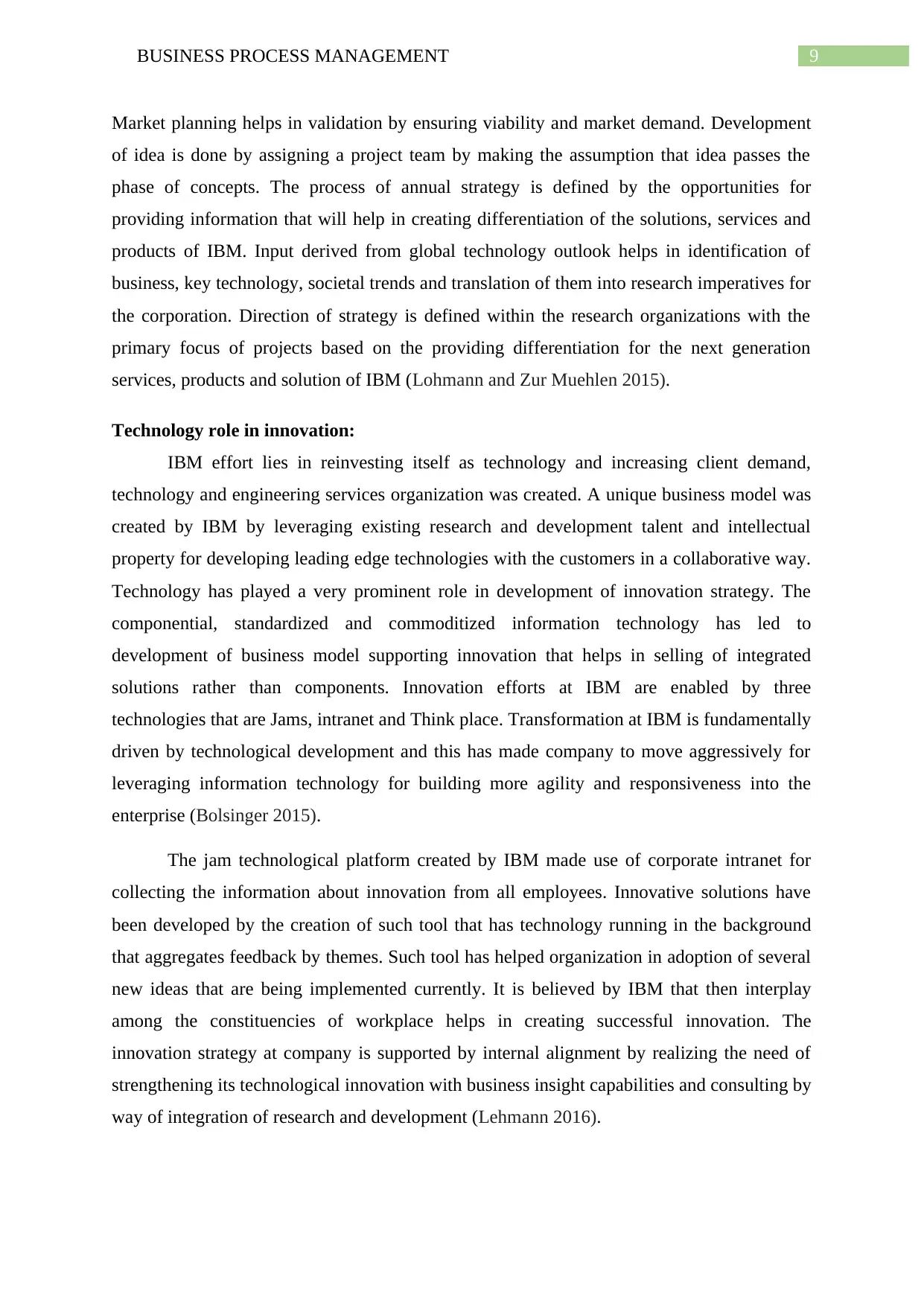
9BUSINESS PROCESS MANAGEMENT
Market planning helps in validation by ensuring viability and market demand. Development
of idea is done by assigning a project team by making the assumption that idea passes the
phase of concepts. The process of annual strategy is defined by the opportunities for
providing information that will help in creating differentiation of the solutions, services and
products of IBM. Input derived from global technology outlook helps in identification of
business, key technology, societal trends and translation of them into research imperatives for
the corporation. Direction of strategy is defined within the research organizations with the
primary focus of projects based on the providing differentiation for the next generation
services, products and solution of IBM (Lohmann and Zur Muehlen 2015).
Technology role in innovation:
IBM effort lies in reinvesting itself as technology and increasing client demand,
technology and engineering services organization was created. A unique business model was
created by IBM by leveraging existing research and development talent and intellectual
property for developing leading edge technologies with the customers in a collaborative way.
Technology has played a very prominent role in development of innovation strategy. The
componential, standardized and commoditized information technology has led to
development of business model supporting innovation that helps in selling of integrated
solutions rather than components. Innovation efforts at IBM are enabled by three
technologies that are Jams, intranet and Think place. Transformation at IBM is fundamentally
driven by technological development and this has made company to move aggressively for
leveraging information technology for building more agility and responsiveness into the
enterprise (Bolsinger 2015).
The jam technological platform created by IBM made use of corporate intranet for
collecting the information about innovation from all employees. Innovative solutions have
been developed by the creation of such tool that has technology running in the background
that aggregates feedback by themes. Such tool has helped organization in adoption of several
new ideas that are being implemented currently. It is believed by IBM that then interplay
among the constituencies of workplace helps in creating successful innovation. The
innovation strategy at company is supported by internal alignment by realizing the need of
strengthening its technological innovation with business insight capabilities and consulting by
way of integration of research and development (Lehmann 2016).
Market planning helps in validation by ensuring viability and market demand. Development
of idea is done by assigning a project team by making the assumption that idea passes the
phase of concepts. The process of annual strategy is defined by the opportunities for
providing information that will help in creating differentiation of the solutions, services and
products of IBM. Input derived from global technology outlook helps in identification of
business, key technology, societal trends and translation of them into research imperatives for
the corporation. Direction of strategy is defined within the research organizations with the
primary focus of projects based on the providing differentiation for the next generation
services, products and solution of IBM (Lohmann and Zur Muehlen 2015).
Technology role in innovation:
IBM effort lies in reinvesting itself as technology and increasing client demand,
technology and engineering services organization was created. A unique business model was
created by IBM by leveraging existing research and development talent and intellectual
property for developing leading edge technologies with the customers in a collaborative way.
Technology has played a very prominent role in development of innovation strategy. The
componential, standardized and commoditized information technology has led to
development of business model supporting innovation that helps in selling of integrated
solutions rather than components. Innovation efforts at IBM are enabled by three
technologies that are Jams, intranet and Think place. Transformation at IBM is fundamentally
driven by technological development and this has made company to move aggressively for
leveraging information technology for building more agility and responsiveness into the
enterprise (Bolsinger 2015).
The jam technological platform created by IBM made use of corporate intranet for
collecting the information about innovation from all employees. Innovative solutions have
been developed by the creation of such tool that has technology running in the background
that aggregates feedback by themes. Such tool has helped organization in adoption of several
new ideas that are being implemented currently. It is believed by IBM that then interplay
among the constituencies of workplace helps in creating successful innovation. The
innovation strategy at company is supported by internal alignment by realizing the need of
strengthening its technological innovation with business insight capabilities and consulting by
way of integration of research and development (Lehmann 2016).
⊘ This is a preview!⊘
Do you want full access?
Subscribe today to unlock all pages.

Trusted by 1+ million students worldwide
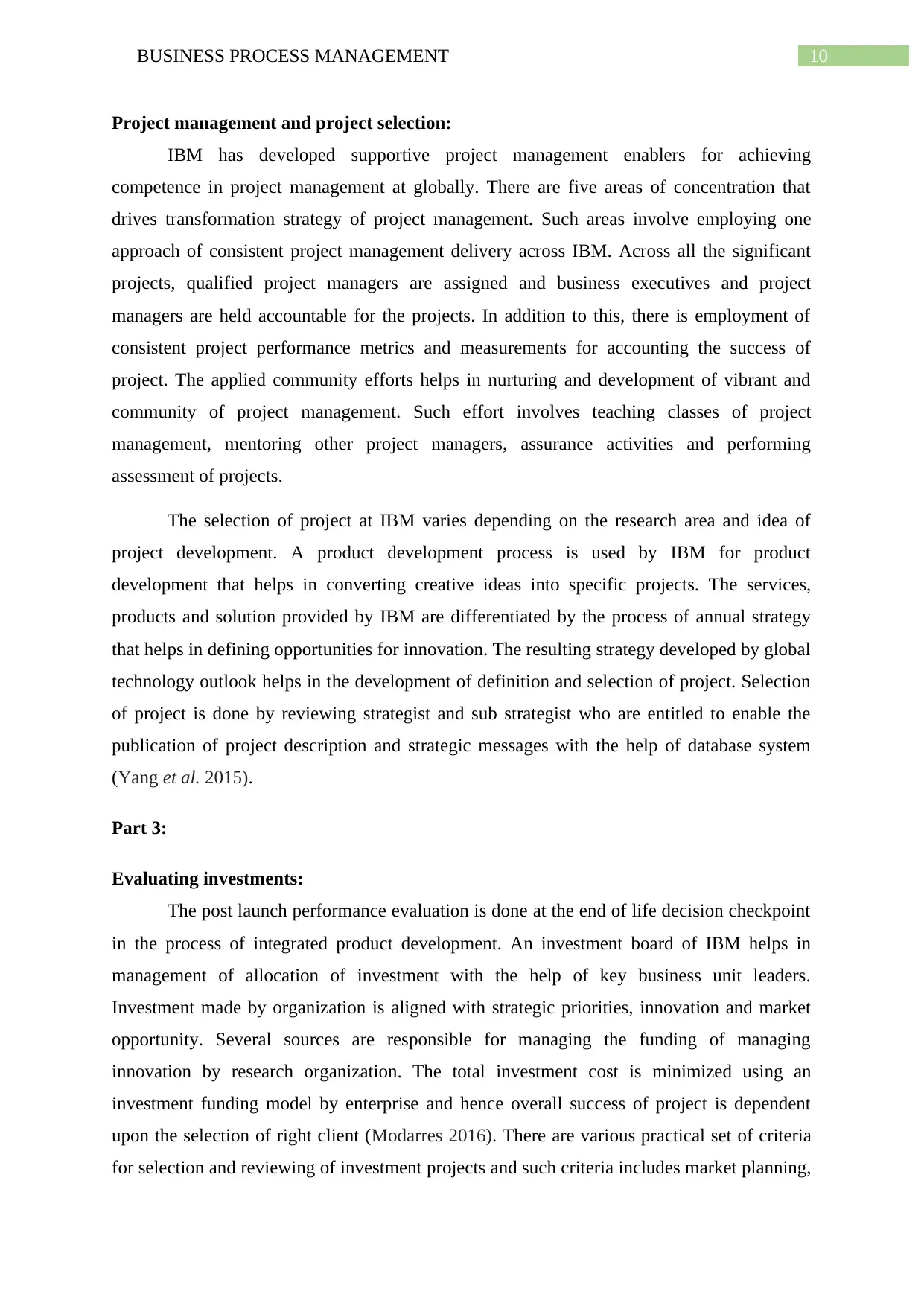
10BUSINESS PROCESS MANAGEMENT
Project management and project selection:
IBM has developed supportive project management enablers for achieving
competence in project management at globally. There are five areas of concentration that
drives transformation strategy of project management. Such areas involve employing one
approach of consistent project management delivery across IBM. Across all the significant
projects, qualified project managers are assigned and business executives and project
managers are held accountable for the projects. In addition to this, there is employment of
consistent project performance metrics and measurements for accounting the success of
project. The applied community efforts helps in nurturing and development of vibrant and
community of project management. Such effort involves teaching classes of project
management, mentoring other project managers, assurance activities and performing
assessment of projects.
The selection of project at IBM varies depending on the research area and idea of
project development. A product development process is used by IBM for product
development that helps in converting creative ideas into specific projects. The services,
products and solution provided by IBM are differentiated by the process of annual strategy
that helps in defining opportunities for innovation. The resulting strategy developed by global
technology outlook helps in the development of definition and selection of project. Selection
of project is done by reviewing strategist and sub strategist who are entitled to enable the
publication of project description and strategic messages with the help of database system
(Yang et al. 2015).
Part 3:
Evaluating investments:
The post launch performance evaluation is done at the end of life decision checkpoint
in the process of integrated product development. An investment board of IBM helps in
management of allocation of investment with the help of key business unit leaders.
Investment made by organization is aligned with strategic priorities, innovation and market
opportunity. Several sources are responsible for managing the funding of managing
innovation by research organization. The total investment cost is minimized using an
investment funding model by enterprise and hence overall success of project is dependent
upon the selection of right client (Modarres 2016). There are various practical set of criteria
for selection and reviewing of investment projects and such criteria includes market planning,
Project management and project selection:
IBM has developed supportive project management enablers for achieving
competence in project management at globally. There are five areas of concentration that
drives transformation strategy of project management. Such areas involve employing one
approach of consistent project management delivery across IBM. Across all the significant
projects, qualified project managers are assigned and business executives and project
managers are held accountable for the projects. In addition to this, there is employment of
consistent project performance metrics and measurements for accounting the success of
project. The applied community efforts helps in nurturing and development of vibrant and
community of project management. Such effort involves teaching classes of project
management, mentoring other project managers, assurance activities and performing
assessment of projects.
The selection of project at IBM varies depending on the research area and idea of
project development. A product development process is used by IBM for product
development that helps in converting creative ideas into specific projects. The services,
products and solution provided by IBM are differentiated by the process of annual strategy
that helps in defining opportunities for innovation. The resulting strategy developed by global
technology outlook helps in the development of definition and selection of project. Selection
of project is done by reviewing strategist and sub strategist who are entitled to enable the
publication of project description and strategic messages with the help of database system
(Yang et al. 2015).
Part 3:
Evaluating investments:
The post launch performance evaluation is done at the end of life decision checkpoint
in the process of integrated product development. An investment board of IBM helps in
management of allocation of investment with the help of key business unit leaders.
Investment made by organization is aligned with strategic priorities, innovation and market
opportunity. Several sources are responsible for managing the funding of managing
innovation by research organization. The total investment cost is minimized using an
investment funding model by enterprise and hence overall success of project is dependent
upon the selection of right client (Modarres 2016). There are various practical set of criteria
for selection and reviewing of investment projects and such criteria includes market planning,
Paraphrase This Document
Need a fresh take? Get an instant paraphrase of this document with our AI Paraphraser
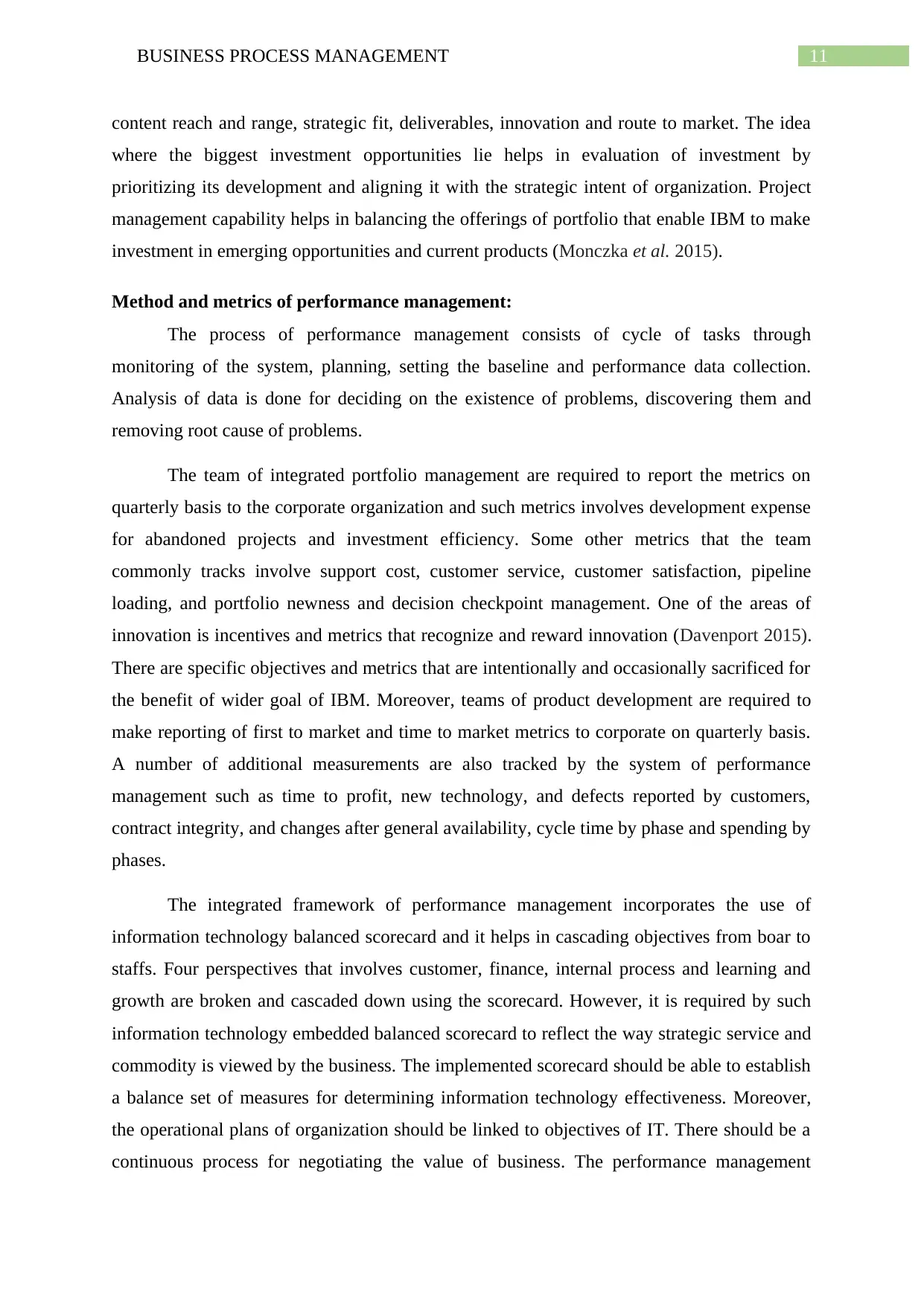
11BUSINESS PROCESS MANAGEMENT
content reach and range, strategic fit, deliverables, innovation and route to market. The idea
where the biggest investment opportunities lie helps in evaluation of investment by
prioritizing its development and aligning it with the strategic intent of organization. Project
management capability helps in balancing the offerings of portfolio that enable IBM to make
investment in emerging opportunities and current products (Monczka et al. 2015).
Method and metrics of performance management:
The process of performance management consists of cycle of tasks through
monitoring of the system, planning, setting the baseline and performance data collection.
Analysis of data is done for deciding on the existence of problems, discovering them and
removing root cause of problems.
The team of integrated portfolio management are required to report the metrics on
quarterly basis to the corporate organization and such metrics involves development expense
for abandoned projects and investment efficiency. Some other metrics that the team
commonly tracks involve support cost, customer service, customer satisfaction, pipeline
loading, and portfolio newness and decision checkpoint management. One of the areas of
innovation is incentives and metrics that recognize and reward innovation (Davenport 2015).
There are specific objectives and metrics that are intentionally and occasionally sacrificed for
the benefit of wider goal of IBM. Moreover, teams of product development are required to
make reporting of first to market and time to market metrics to corporate on quarterly basis.
A number of additional measurements are also tracked by the system of performance
management such as time to profit, new technology, and defects reported by customers,
contract integrity, and changes after general availability, cycle time by phase and spending by
phases.
The integrated framework of performance management incorporates the use of
information technology balanced scorecard and it helps in cascading objectives from boar to
staffs. Four perspectives that involves customer, finance, internal process and learning and
growth are broken and cascaded down using the scorecard. However, it is required by such
information technology embedded balanced scorecard to reflect the way strategic service and
commodity is viewed by the business. The implemented scorecard should be able to establish
a balance set of measures for determining information technology effectiveness. Moreover,
the operational plans of organization should be linked to objectives of IT. There should be a
continuous process for negotiating the value of business. The performance management
content reach and range, strategic fit, deliverables, innovation and route to market. The idea
where the biggest investment opportunities lie helps in evaluation of investment by
prioritizing its development and aligning it with the strategic intent of organization. Project
management capability helps in balancing the offerings of portfolio that enable IBM to make
investment in emerging opportunities and current products (Monczka et al. 2015).
Method and metrics of performance management:
The process of performance management consists of cycle of tasks through
monitoring of the system, planning, setting the baseline and performance data collection.
Analysis of data is done for deciding on the existence of problems, discovering them and
removing root cause of problems.
The team of integrated portfolio management are required to report the metrics on
quarterly basis to the corporate organization and such metrics involves development expense
for abandoned projects and investment efficiency. Some other metrics that the team
commonly tracks involve support cost, customer service, customer satisfaction, pipeline
loading, and portfolio newness and decision checkpoint management. One of the areas of
innovation is incentives and metrics that recognize and reward innovation (Davenport 2015).
There are specific objectives and metrics that are intentionally and occasionally sacrificed for
the benefit of wider goal of IBM. Moreover, teams of product development are required to
make reporting of first to market and time to market metrics to corporate on quarterly basis.
A number of additional measurements are also tracked by the system of performance
management such as time to profit, new technology, and defects reported by customers,
contract integrity, and changes after general availability, cycle time by phase and spending by
phases.
The integrated framework of performance management incorporates the use of
information technology balanced scorecard and it helps in cascading objectives from boar to
staffs. Four perspectives that involves customer, finance, internal process and learning and
growth are broken and cascaded down using the scorecard. However, it is required by such
information technology embedded balanced scorecard to reflect the way strategic service and
commodity is viewed by the business. The implemented scorecard should be able to establish
a balance set of measures for determining information technology effectiveness. Moreover,
the operational plans of organization should be linked to objectives of IT. There should be a
continuous process for negotiating the value of business. The performance management
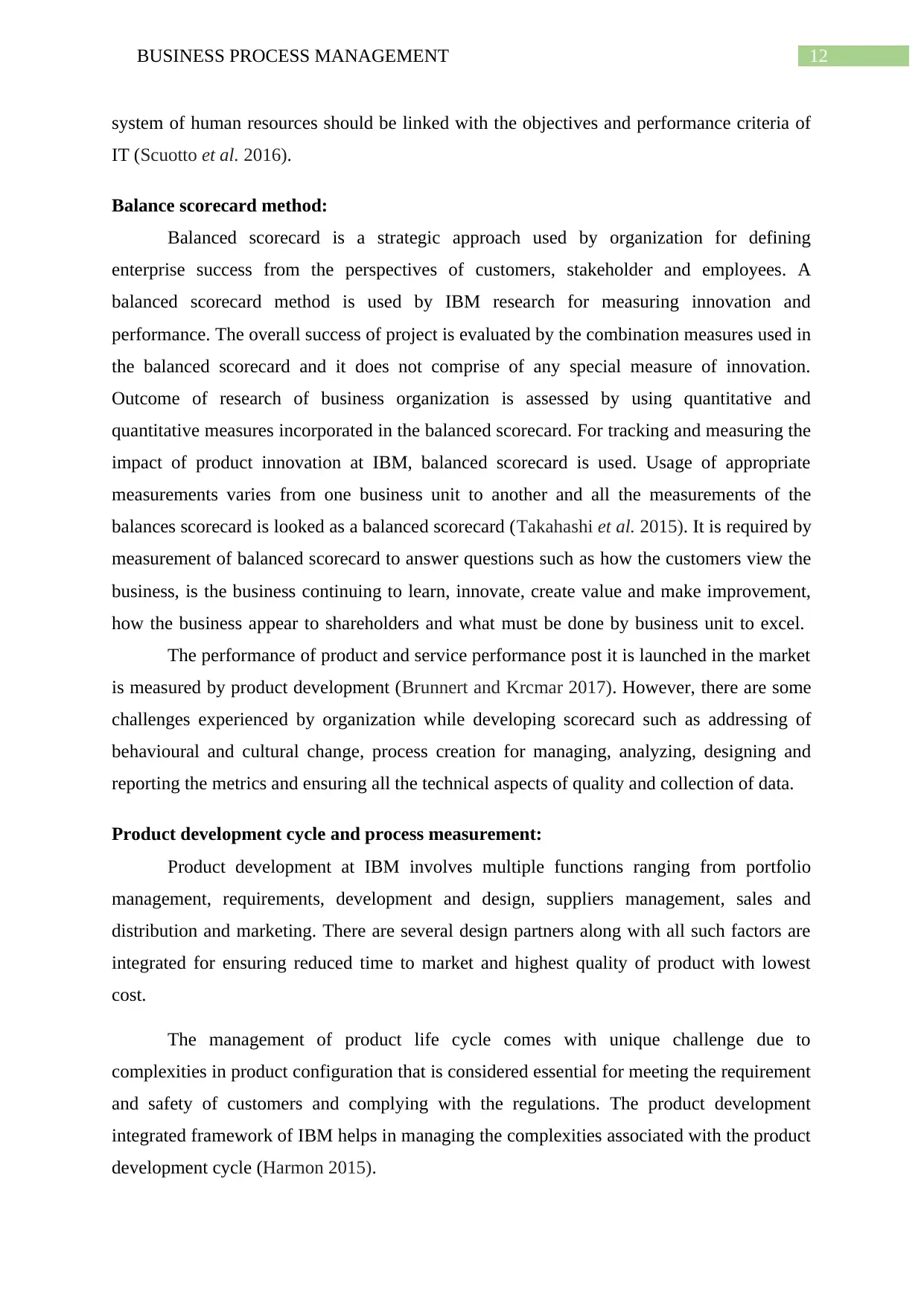
12BUSINESS PROCESS MANAGEMENT
system of human resources should be linked with the objectives and performance criteria of
IT (Scuotto et al. 2016).
Balance scorecard method:
Balanced scorecard is a strategic approach used by organization for defining
enterprise success from the perspectives of customers, stakeholder and employees. A
balanced scorecard method is used by IBM research for measuring innovation and
performance. The overall success of project is evaluated by the combination measures used in
the balanced scorecard and it does not comprise of any special measure of innovation.
Outcome of research of business organization is assessed by using quantitative and
quantitative measures incorporated in the balanced scorecard. For tracking and measuring the
impact of product innovation at IBM, balanced scorecard is used. Usage of appropriate
measurements varies from one business unit to another and all the measurements of the
balances scorecard is looked as a balanced scorecard (Takahashi et al. 2015). It is required by
measurement of balanced scorecard to answer questions such as how the customers view the
business, is the business continuing to learn, innovate, create value and make improvement,
how the business appear to shareholders and what must be done by business unit to excel.
The performance of product and service performance post it is launched in the market
is measured by product development (Brunnert and Krcmar 2017). However, there are some
challenges experienced by organization while developing scorecard such as addressing of
behavioural and cultural change, process creation for managing, analyzing, designing and
reporting the metrics and ensuring all the technical aspects of quality and collection of data.
Product development cycle and process measurement:
Product development at IBM involves multiple functions ranging from portfolio
management, requirements, development and design, suppliers management, sales and
distribution and marketing. There are several design partners along with all such factors are
integrated for ensuring reduced time to market and highest quality of product with lowest
cost.
The management of product life cycle comes with unique challenge due to
complexities in product configuration that is considered essential for meeting the requirement
and safety of customers and complying with the regulations. The product development
integrated framework of IBM helps in managing the complexities associated with the product
development cycle (Harmon 2015).
system of human resources should be linked with the objectives and performance criteria of
IT (Scuotto et al. 2016).
Balance scorecard method:
Balanced scorecard is a strategic approach used by organization for defining
enterprise success from the perspectives of customers, stakeholder and employees. A
balanced scorecard method is used by IBM research for measuring innovation and
performance. The overall success of project is evaluated by the combination measures used in
the balanced scorecard and it does not comprise of any special measure of innovation.
Outcome of research of business organization is assessed by using quantitative and
quantitative measures incorporated in the balanced scorecard. For tracking and measuring the
impact of product innovation at IBM, balanced scorecard is used. Usage of appropriate
measurements varies from one business unit to another and all the measurements of the
balances scorecard is looked as a balanced scorecard (Takahashi et al. 2015). It is required by
measurement of balanced scorecard to answer questions such as how the customers view the
business, is the business continuing to learn, innovate, create value and make improvement,
how the business appear to shareholders and what must be done by business unit to excel.
The performance of product and service performance post it is launched in the market
is measured by product development (Brunnert and Krcmar 2017). However, there are some
challenges experienced by organization while developing scorecard such as addressing of
behavioural and cultural change, process creation for managing, analyzing, designing and
reporting the metrics and ensuring all the technical aspects of quality and collection of data.
Product development cycle and process measurement:
Product development at IBM involves multiple functions ranging from portfolio
management, requirements, development and design, suppliers management, sales and
distribution and marketing. There are several design partners along with all such factors are
integrated for ensuring reduced time to market and highest quality of product with lowest
cost.
The management of product life cycle comes with unique challenge due to
complexities in product configuration that is considered essential for meeting the requirement
and safety of customers and complying with the regulations. The product development
integrated framework of IBM helps in managing the complexities associated with the product
development cycle (Harmon 2015).
⊘ This is a preview!⊘
Do you want full access?
Subscribe today to unlock all pages.

Trusted by 1+ million students worldwide
1 out of 21
Related Documents
Your All-in-One AI-Powered Toolkit for Academic Success.
+13062052269
info@desklib.com
Available 24*7 on WhatsApp / Email
![[object Object]](/_next/static/media/star-bottom.7253800d.svg)
Unlock your academic potential
Copyright © 2020–2025 A2Z Services. All Rights Reserved. Developed and managed by ZUCOL.





